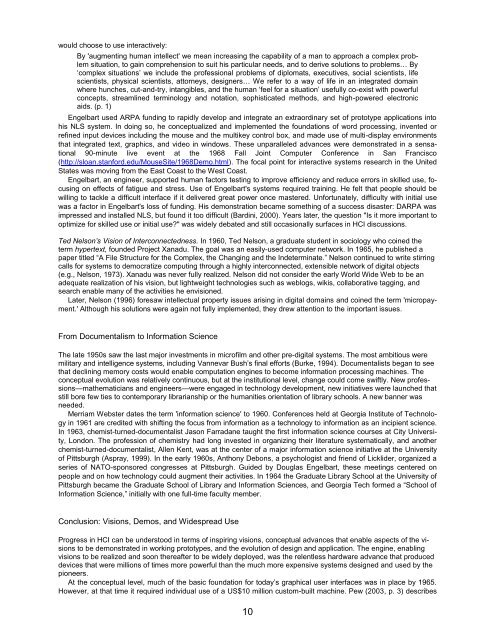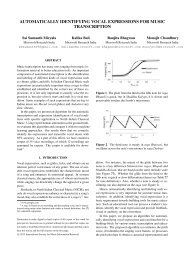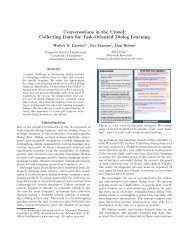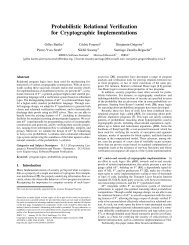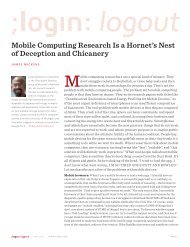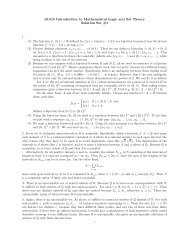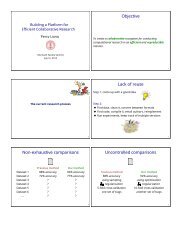A Moving Target—The Evolution of Human-Computer Interaction
A Moving Target—The Evolution of Human-Computer Interaction
A Moving Target—The Evolution of Human-Computer Interaction
You also want an ePaper? Increase the reach of your titles
YUMPU automatically turns print PDFs into web optimized ePapers that Google loves.
would choose to use interactively:<br />
By 'augmenting human intellect' we mean increasing the capability <strong>of</strong> a man to approach a complex problem<br />
situation, to gain comprehension to suit his particular needs, and to derive solutions to problems… By<br />
‘complex situations’ we include the pr<strong>of</strong>essional problems <strong>of</strong> diplomats, executives, social scientists, life<br />
scientists, physical scientists, attorneys, designers… We refer to a way <strong>of</strong> life in an integrated domain<br />
where hunches, cut-and-try, intangibles, and the human ‘feel for a situation’ usefully co-exist with powerful<br />
concepts, streamlined terminology and notation, sophisticated methods, and high-powered electronic<br />
aids. (p. 1)<br />
Engelbart used ARPA funding to rapidly develop and integrate an extraordinary set <strong>of</strong> prototype applications into<br />
his NLS system. In doing so, he conceptualized and implemented the foundations <strong>of</strong> word processing, invented or<br />
refined input devices including the mouse and the multikey control box, and made use <strong>of</strong> multi-display environments<br />
that integrated text, graphics, and video in windows. These unparalleled advances were demonstrated in a sensational<br />
90-minute live event at the 1968 Fall Joint <strong>Computer</strong> Conference in San Francisco<br />
(http://sloan.stanford.edu/MouseSite/1968Demo.html). The focal point for interactive systems research in the United<br />
States was moving from the East Coast to the West Coast.<br />
Engelbart, an engineer, supported human factors testing to improve efficiency and reduce errors in skilled use, focusing<br />
on effects <strong>of</strong> fatigue and stress. Use <strong>of</strong> Engelbart's systems required training. He felt that people should be<br />
willing to tackle a difficult interface if it delivered great power once mastered. Unfortunately, difficulty with initial use<br />
was a factor in Engelbart's loss <strong>of</strong> funding. His demonstration became something <strong>of</strong> a success disaster: DARPA was<br />
impressed and installed NLS, but found it too difficult (Bardini, 2000). Years later, the question "Is it more important to<br />
optimize for skilled use or initial use?" was widely debated and still occasionally surfaces in HCI discussions.<br />
Ted Nelson’s Vision <strong>of</strong> Interconnectedness. In 1960, Ted Nelson, a graduate student in sociology who coined the<br />
term hypertext, founded Project Xanadu. The goal was an easily-used computer network. In 1965, he published a<br />
paper titled “A File Structure for the Complex, the Changing and the Indeterminate.” Nelson continued to write stirring<br />
calls for systems to democratize computing through a highly interconnected, extensible network <strong>of</strong> digital objects<br />
(e.g., Nelson, 1973). Xanadu was never fully realized. Nelson did not consider the early World Wide Web to be an<br />
adequate realization <strong>of</strong> his vision, but lightweight technologies such as weblogs, wikis, collaborative tagging, and<br />
search enable many <strong>of</strong> the activities he envisioned.<br />
Later, Nelson (1996) foresaw intellectual property issues arising in digital domains and coined the term 'micropayment.'<br />
Although his solutions were again not fully implemented, they drew attention to the important issues.<br />
From Documentalism to Information Science<br />
The late 1950s saw the last major investments in micr<strong>of</strong>ilm and other pre-digital systems. The most ambitious were<br />
military and intelligence systems, including Vannevar Bush’s final efforts (Burke, 1994). Documentalists began to see<br />
that declining memory costs would enable computation engines to become information processing machines. The<br />
conceptual evolution was relatively continuous, but at the institutional level, change could come swiftly. New pr<strong>of</strong>essions—mathematicians<br />
and engineers—were engaged in technology development, new initiatives were launched that<br />
still bore few ties to contemporary librarianship or the humanities orientation <strong>of</strong> library schools. A new banner was<br />
needed.<br />
Merriam Webster dates the term 'information science' to 1960. Conferences held at Georgia Institute <strong>of</strong> Technology<br />
in 1961 are credited with shifting the focus from information as a technology to information as an incipient science.<br />
In 1963, chemist-turned-documentalist Jason Farradane taught the first information science courses at City University,<br />
London. The pr<strong>of</strong>ession <strong>of</strong> chemistry had long invested in organizing their literature systematically, and another<br />
chemist-turned-documentalist, Allen Kent, was at the center <strong>of</strong> a major information science initiative at the University<br />
<strong>of</strong> Pittsburgh (Aspray, 1999). In the early 1960s, Anthony Debons, a psychologist and friend <strong>of</strong> Licklider, organized a<br />
series <strong>of</strong> NATO-sponsored congresses at Pittsburgh. Guided by Douglas Engelbart, these meetings centered on<br />
people and on how technology could augment their activities. In 1964 the Graduate Library School at the University <strong>of</strong><br />
Pittsburgh became the Graduate School <strong>of</strong> Library and Information Sciences, and Georgia Tech formed a “School <strong>of</strong><br />
Information Science,” initially with one full-time faculty member.<br />
Conclusion: Visions, Demos, and Widespread Use<br />
Progress in HCI can be understood in terms <strong>of</strong> inspiring visions, conceptual advances that enable aspects <strong>of</strong> the visions<br />
to be demonstrated in working prototypes, and the evolution <strong>of</strong> design and application. The engine, enabling<br />
visions to be realized and soon thereafter to be widely deployed, was the relentless hardware advance that produced<br />
devices that were millions <strong>of</strong> times more powerful than the much more expensive systems designed and used by the<br />
pioneers.<br />
At the conceptual level, much <strong>of</strong> the basic foundation for today’s graphical user interfaces was in place by 1965.<br />
However, at that time it required individual use <strong>of</strong> a US$10 million custom-built machine. Pew (2003, p. 3) describes<br />
10


